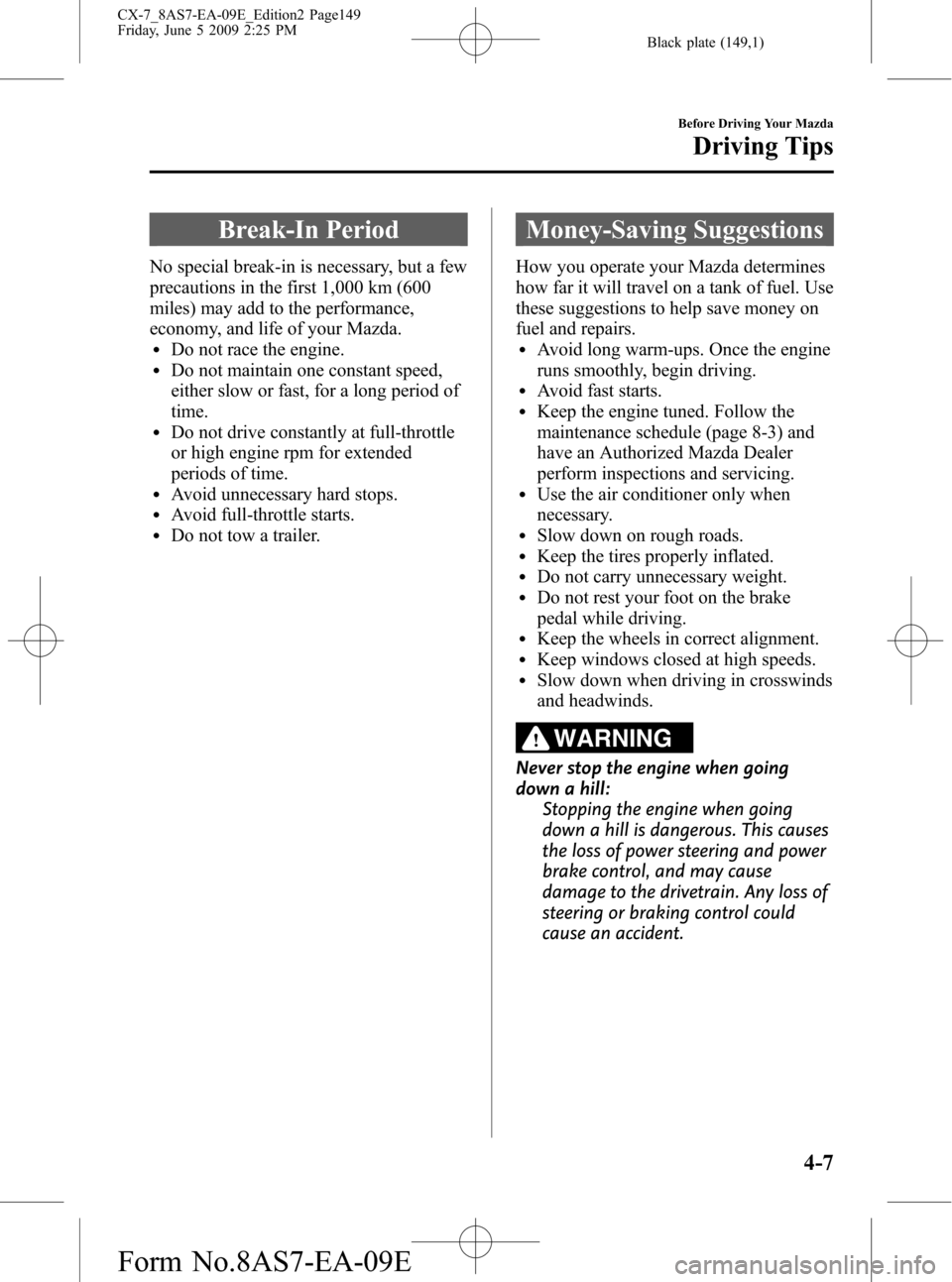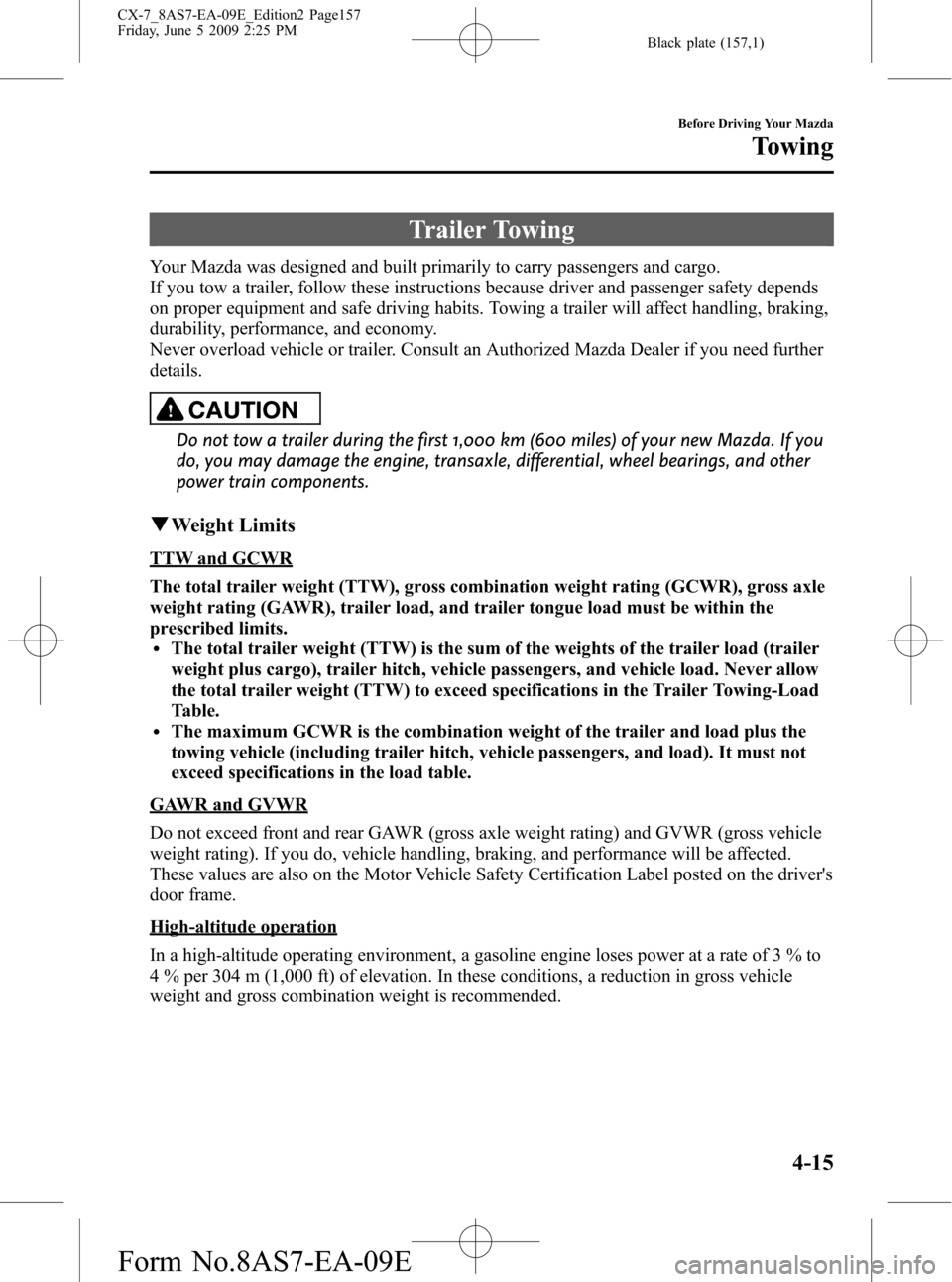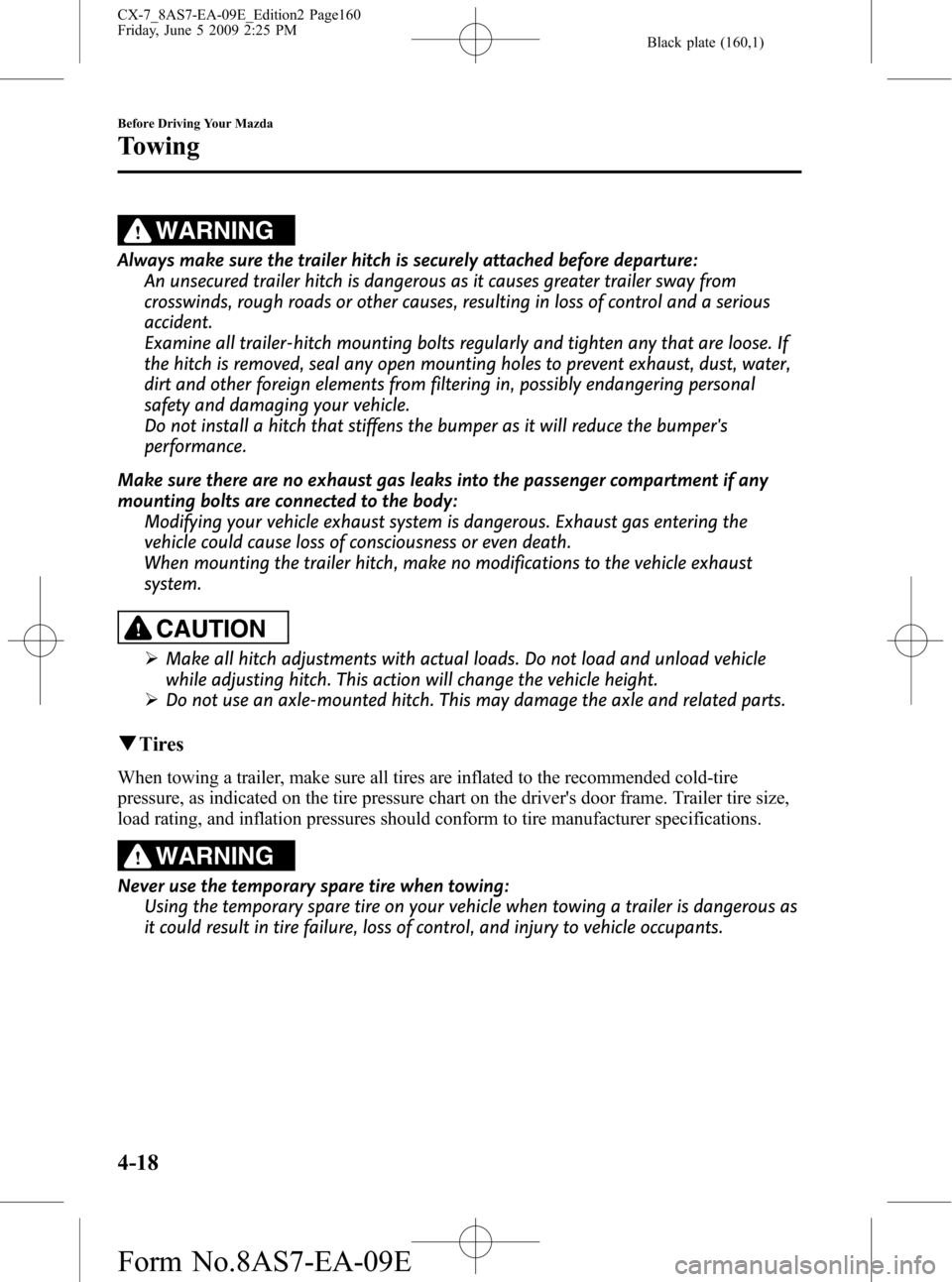tow MAZDA MODEL CX-7 2010 Owners Manual (in English)
[x] Cancel search | Manufacturer: MAZDA, Model Year: 2010, Model line: MODEL CX-7, Model: MAZDA MODEL CX-7 2010Pages: 510, PDF Size: 8.55 MB
Page 38 of 510

Black plate (38,1)
CAUTION
Always unfasten the lap portion of
the belt before folding the left-rear
seatback. Leaving the lap portion of
the belt fastened could cause
damage to the seat belt, seat belt
buckle and seatback.
qStowing and pulling out the
Center-Rear Position Seat Belt
The center-rear position seat belt can be
stowed using the following procedure.
CAUTION
When stowing the seat belt, make
sure the belt is locked securely into
the recess. If the seat belt is not
properly stowed, it might get caught
in the seats and be damaged.
To stow the seat belt, retract the belt, put
the seat belt tongues (A) and (C) together
and insert them into the recess.
(A)
(C) Ceiling recess
To pull out the seat belt, slide the seat belt
tongue (A) with your finger while moving
it downward, and slowly pull out the seat
belt from the ceiling recess.
NOTElTo encourage rear seat passengers to wear
their seat belts, we suggest leaving the
center-rear lap position of the belt fastened
at all times except when folding the rear
seat forward.
lPulling the seat belt all the way out will
switch it to automatic locking mode. If
automatic locking mode is not needed,
retract the seat belt fully to convert it back
to emergency locking mode.
qRe-attaching the Seat Belt after
the Rear Seatbacks are Returned
to their Upright Positions
To re-attach the center seat belt after the
rear seats are returned to their upright
positions, grasp the seat belt tongue (A)
and insert it into the seat belt anchor
buckle (B) until you hear a click sound. It
is now secure for passenger use.
NOTE
After returning the left-rear seatback to its
upright position, fasten the lap portion of the
belt.
2-26
Essential Safety Equipment
Seat Belt Systems
CX-7_8AS7-EA-09E_Edition2 Page38
Friday, June 5 2009 2:24 PM
Form No.8AS7-EA-09E
Page 42 of 510

Black plate (42,1)
Child Restraint Precautions
Mazda strongly urges the use of child-restraint systems for children small enough to use
them.
You are required by law to use a child-restraint system for children in the U.S. and Canada.
Check your local and state or provincial laws for specific requirements regarding the safety
of children riding in your vehicle.
Whatever child-restraint system you consider, please pick the appropriate one for the age
and size of the child, obey the law and follow the instructions that come with the individual
child-restraint system.
A child who has outgrown child-restraint systems should sit in the rear and use seat belts,
both lap and shoulder. If the shoulder belt crosses the neck or face, move the child closer to
the center of the vehicle in the outboard seats, and towards the buckle on the right if the
child is seated on the center seat.
Statistics confirm that the rear seat is the best place for all children up to 12 years of age,
and more so with a supplemental restraint system (air bags).
A rear-facing child-restraint system shouldNEVERbe used on the front seat with the air
bag system activated. The front passenger's seat is also the least preferred seat for other
child-restraint systems.
To reduce the chance of injuries caused by deployment of the front passenger air bag, the
front passenger seat weight sensors work as a part of the supplemental restraint system.
This system deactivates the front passenger front and side air bags and also the front
passenger seat belt pretensioner system when the total seated weight on the front passenger
seat is less than approximately 30 kg (66 lb).
When an infant or small child sits on the front passenger seat, the system shuts off the front
passenger front and side air bags and seat belt pretensioner system, so make sure the front
passenger air bag deactivation indicator light illuminates.
Even if the front passenger air bag is shut off, Mazda strongly recommends that children be
properly restrained and child-restraint systems of all kinds are properly secured on the rear
seats which are the best place for children.
For more details, refer to“Front passenger seat weight sensors”(page 2-57).
2-30
Essential Safety Equipment
Child Restraint
CX-7_8AS7-EA-09E_Edition2 Page42
Friday, June 5 2009 2:24 PM
Form No.8AS7-EA-09E
Page 107 of 510

Black plate (107,1)
Door Locks
WARNING
Always take all children and pets with
you or leave a responsible person with
them:
Leaving a child or a pet unattended
in a parked vehicle is dangerous. In
hot weather, temperatures inside a
vehicle can become high enough to
cause brain damage or even death.
Do not leave the key in your vehicle
with children and keep them in a place
where your children will not find or
play with them:
Leaving children in a vehicle with the
key is dangerous. This could result in
someone being badly injured or even
killed.
Keep all doors locked when driving:
Unlocked doors in a moving vehicle
are dangerous. Passengers can fall
out if a door is accidentally opened
and can more easily be thrown out in
an accident.
Always close all the windows and the
moonroof, lock the doors and take the
key with you when leaving your vehicle
unattended:
Leaving your vehicle unlocked is
dangerous as children could lock
themselves in a hot vehicle, which
could result in death. Also, a vehicle
left unlocked becomes an easy target
for thieves and intruders.
qLocking, Unlocking with Key
The driver's door can be locked/unlocked
with the key.
Turn the key toward the front to unlock,
toward the back to lock.
Unlock
Lock
qLocking, Unlocking with Request
Switch (with Advanced Key)
The doors can be locked/unlocked by
operating the request switch while
carrying the advanced key outside the
vehicle, refer to Operations Using
Advanced Keyless Functions (page 3-7).
qLocking, Unlocking with
Transmitter (with Advanced Key)
The doors can be locked/unlocked by
operating the keyless entry system
transmitter, refer to Keyless Entry System
(page 3-14).
qLocking, Unlocking with Transmitter
(with Retractable Type Key)
The doors can be locked/unlocked by
operating the keyless entry system
transmitter, refer to Keyless Entry System
(page 3-24).
Knowing Your Mazda
Doors and Locks
3-31
CX-7_8AS7-EA-09E_Edition2 Page107
Friday, June 5 2009 2:24 PM
Form No.8AS7-EA-09E
Page 143 of 510

Black plate (143,1)
4Before Driving Your Mazda
Important information about driving your Mazda.
Fuel and Engine Exhaust Precautions ........................................ 4-2
Fuel Requirements .................................................................... 4-2
Emission Control System .......................................................... 4-4
Engine Exhaust (Carbon Monoxide) ......................................... 4-5
Before Starting the Engine ........................................................... 4-6
Before Getting In ...................................................................... 4-6
After Getting In ......................................................................... 4-6
Driving Tips ................................................................................... 4-7
Break-In Period ......................................................................... 4-7
Money-Saving Suggestions ...................................................... 4-7
Hazardous Driving .................................................................... 4-8
Floor Mat .................................................................................. 4-9
Rocking the Vehicle .................................................................. 4-9
Winter Driving ........................................................................ 4-10
Driving In Flooded Area ......................................................... 4-11
Overloading ............................................................................ 4-12
Driving on Uneven Road ........................................................ 4-13
Turbocharger Information
í.................................................... 4-14
Towing ......................................................................................... 4-15
Trailer Towing ......................................................................... 4-15
4-1íSome models.
CX-7_8AS7-EA-09E_Edition2 Page143
Friday, June 5 2009 2:25 PM
Form No.8AS7-EA-09E
Page 149 of 510

Black plate (149,1)
Break-In Period
No special break-in is necessary, but a few
precautions in the first 1,000 km (600
miles) may add to the performance,
economy, and life of your Mazda.
lDo not race the engine.lDo not maintain one constant speed,
either slow or fast, for a long period of
time.
lDo not drive constantly at full-throttle
or high engine rpm for extended
periods of time.
lAvoid unnecessary hard stops.lAvoid full-throttle starts.lDo not tow a trailer.
Money-Saving Suggestions
How you operate your Mazda determines
how far it will travel on a tank of fuel. Use
these suggestions to help save money on
fuel and repairs.
lAvoid long warm-ups. Once the engine
runs smoothly, begin driving.
lAvoid fast starts.lKeep the engine tuned. Follow the
maintenance schedule (page 8-3) and
have an Authorized Mazda Dealer
perform inspections and servicing.
lUse the air conditioner only when
necessary.
lSlow down on rough roads.lKeep the tires properly inflated.lDo not carry unnecessary weight.lDo not rest your foot on the brake
pedal while driving.
lKeep the wheels in correct alignment.lKeep windows closed at high speeds.lSlow down when driving in crosswinds
and headwinds.
WARNING
Never stop the engine when going
down a hill:
Stopping the engine when going
down a hill is dangerous. This causes
the loss of power steering and power
brake control, and may cause
damage to the drivetrain. Any loss of
steering or braking control could
cause an accident.
Before Driving Your Mazda
Driving Tips
4-7
CX-7_8AS7-EA-09E_Edition2 Page149
Friday, June 5 2009 2:25 PM
Form No.8AS7-EA-09E
Page 157 of 510

Black plate (157,1)
Trailer Towing
Your Mazda was designed and built primarily to carry passengers and cargo.
If you tow a trailer, follow these instructions because driver and passenger safety depends
on proper equipment and safe driving habits. Towing a trailer will affect handling, braking,
durability, performance, and economy.
Never overload vehicle or trailer. Consult an Authorized Mazda Dealer if you need further
details.
CAUTION
Do not tow a trailer during the first 1,000 km (600 miles) of your new Mazda. If you
do, you may damage the engine, transaxle, differential, wheel bearings, and other
power train components.
qWeight Limits
TTW and GCWR
The total trailer weight (TTW), gross combination weight rating (GCWR), gross axle
weight rating (GAWR), trailer load, and trailer tongue load must be within the
prescribed limits.
lThe total trailer weight (TTW) is the sum of the weights of the trailer load (trailer
weight plus cargo), trailer hitch, vehicle passengers, and vehicle load. Never allow
the total trailer weight (TTW) to exceed specifications in the Trailer Towing-Load
Table.
lThe maximum GCWR is the combination weight of the trailer and load plus the
towing vehicle (including trailer hitch, vehicle passengers, and load). It must not
exceed specifications in the load table.
GAWR and GVWR
Do not exceed front and rear GAWR (gross axle weight rating) and GVWR (gross vehicle
weight rating). If you do, vehicle handling, braking, and performance will be affected.
These values are also on the Motor Vehicle Safety Certification Label posted on the driver's
door frame.
High-altitude operation
In a high-altitude operating environment, a gasoline engine loses power at a rate of 3 % to
4 % per 304 m (1,000 ft) of elevation. In these conditions, a reduction in gross vehicle
weight and gross combination weight is recommended.
Before Driving Your Mazda
Towing
4-15
CX-7_8AS7-EA-09E_Edition2 Page157
Friday, June 5 2009 2:25 PM
Form No.8AS7-EA-09E
Page 158 of 510

Black plate (158,1)
TRAILER TOWING-LOAD TABLE
Because vehicle weights vary, adjustments must be made to meet the requirements in this
table.
ItemModel
2.3-liter engine2.5-liter
engine
2WD AWD 2WD
MAX.
FRONTAL
AREA
2.97 m2(32 ft2)
MAX. TTWAdd trailer's weight, load and hitch; vehicle
passengers and vehicle load
*
907 kg (2,000 lb)680 kg
(1,500 lb)
MAX. GCWR
2,815 kg
(6,206 lb)2,914 kg
(6,424 lb)2,526 kg
(5,569 lb)
MAX. GAWR
Front1,150 kg
(2,535 lb)1,189 kg
(2,621 lb)1,104 kg
(2,434 lb)
Rear1,022 kg
(2,253 lb)1,083 kg
(2,388 lb)1,025 kg
(2,260 lb)
MAX. GVWR
2,168 kg
(4,780 lb)2,267 kg
(4,998 lb)2,125 kg
(4,685 lb)
TRAILER-
TONGUE
LOADTongue load
Tongue load/Trailer load × 100 = 10 % to 15 %
Trailer load
DISTRIBU-
TION OF
TRAILER
LOADFront 60 %
Rear 40 %
* i.e. baggage, food, camp gear
GCWR: Gross Combination Weight Rating (sum of TTW, vehicle weights and 2
passengers)
GAWR: Gross Axle Weight Rating
GVWR: Gross Vehicle Weight Rating
4-16
Before Driving Your Mazda
Towing
CX-7_8AS7-EA-09E_Edition2 Page158
Friday, June 5 2009 2:25 PM
Form No.8AS7-EA-09E
Page 159 of 510

Black plate (159,1)
WARNING
Always keep tow loads within specified limits as indicated in the Trailer Towing-Load
Table:
Attempting to tow loads greater than those specified is dangerous as it may cause
serious handling and performance problems that could result in personal injury or
vehicle damage, or both.
Load your trailer with the weight about 60 % toward the front and 40 % toward the
rear:
Loading the trailer with more weight in the rear than in the front is dangerous.
Doing so could cause you to lose control. The trailer tongue load must be 10 %―15
% of the total trailer load (sum of the weights of the trailer and cargo).
Always have the total trailer weight and tongue load determined prior to departure:
Attempting to tow loads without determining the total trailer weight and tongue
load is dangerous. Trailer sway from crosswinds, rough roads or other causes could
result in loss of control and a serious accident.
CAUTION
The total trailer weight and tongue load can be determined by weighing the trailer
on platform scales at a highway weight station or a trucking company.
qTrailer Hitch
Use only a hitch ball recommended by the trailer manufacturer that conforms to the gross
trailer weight requirement.
When not towing a trailer, remove the trailer hitch (if detachable) to reduce the possibility
of damage as a result of the vehicle being rear-ended.
Before Driving Your Mazda
Towing
4-17
CX-7_8AS7-EA-09E_Edition2 Page159
Friday, June 5 2009 2:25 PM
Form No.8AS7-EA-09E
Page 160 of 510

Black plate (160,1)
WARNING
Always make sure the trailer hitch is securely attached before departure:
An unsecured trailer hitch is dangerous as it causes greater trailer sway from
crosswinds, rough roads or other causes, resulting in loss of control and a serious
accident.
Examine all trailer-hitch mounting bolts regularly and tighten any that are loose. If
the hitch is removed, seal any open mounting holes to prevent exhaust, dust, water,
dirt and other foreign elements from filtering in, possibly endangering personal
safety and damaging your vehicle.
Do not install a hitch that stiffens the bumper as it will reduce the bumper's
performance.
Make sure there are no exhaust gas leaks into the passenger compartment if any
mounting bolts are connected to the body:
Modifying your vehicle exhaust system is dangerous. Exhaust gas entering the
vehicle could cause loss of consciousness or even death.
When mounting the trailer hitch, make no modifications to the vehicle exhaust
system.
CAUTION
ØMake all hitch adjustments with actual loads. Do not load and unload vehicle
while adjusting hitch. This action will change the vehicle height.
ØDo not use an axle-mounted hitch. This may damage the axle and related parts.
qTires
When towing a trailer, make sure all tires are inflated to the recommended cold-tire
pressure, as indicated on the tire pressure chart on the driver's door frame. Trailer tire size,
load rating, and inflation pressures should conform to tire manufacturer specifications.
WARNING
Never use the temporary spare tire when towing:
Using the temporary spare tire on your vehicle when towing a trailer is dangerous as
it could result in tire failure, loss of control, and injury to vehicle occupants.
4-18
Before Driving Your Mazda
Towing
CX-7_8AS7-EA-09E_Edition2 Page160
Friday, June 5 2009 2:25 PM
Form No.8AS7-EA-09E
Page 161 of 510

Black plate (161,1)
qSafety Chains
Safety chains must be used as a precautionary measure should the trailer become
unintentionally unhitched. They should cross under the trailer tongue and attach to the
hitch. Leave enough slack to allow full turns. Consult literature published by your trailer or
hitch manufacturer for more details.
WARNING
Make sure the safety chain is securely attached to both the trailer and the vehicle
prior to departure:
Towing a trailer without using a safety chain securely attached to both the trailer
and the vehicle is dangerous. If damage occurs to the coupling unit or hitch ball, the
trailer could wander into another lane and cause a collision.
qTrailer Lights
Trailer lights must comply with all federal, state, and local regulations. Equip your trailer
as required before towing it day or night.
CAUTION
Do not connect a trailer lighting system directly to the lighting system of your
Mazda. This may damage your vehicle's electrical system and lighting systems. Have
a recreational vehicle dealer or trailer rental agency connect the system, and inspect
the brake lights and turn signals yourself before each trip.
qTrailer Brakes
If the total trailer weight exceeds 450 kg (1,000 lb), trailer brakes are required. If your
trailer has brakes, make sure they comply with all federal, state, and local regulations.
WARNING
Do not connect a hydraulic trailer-brake system to your vehicle's brake system:
Connecting a hydraulic trailer-brake system directly to the vehicle brake system is
dangerous and will result in inadequate braking and possible injury.
qTrailer Towing Tips
lVerify that your Mazda maintains a near-normal attitude when a loaded or unloaded
trailer is connected. Do not drive if it has an abnormal front-up or front-down position.
Inspect for incorrect tongue load, worn suspension parts, and trailer overloading.
lMake sure the trailer is properly loaded and the cargo is secure to prevent it from
shifting.
lMake sure the mirrors conform to all government regulations. If they do not, install
required rear view mirrors appropriate for towing purposes.
Before Driving Your Mazda
Towing
4-19
CX-7_8AS7-EA-09E_Edition2 Page161
Friday, June 5 2009 2:25 PM
Form No.8AS7-EA-09E